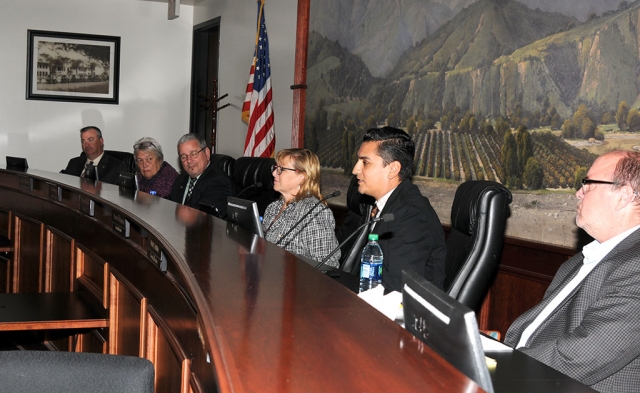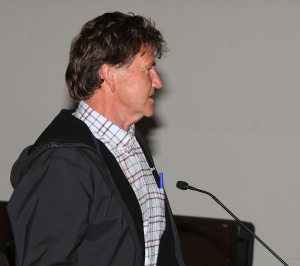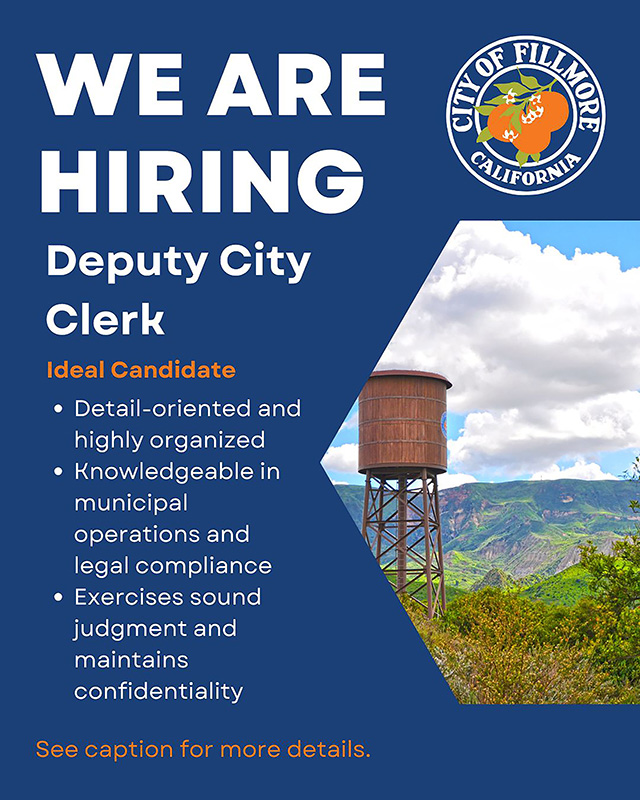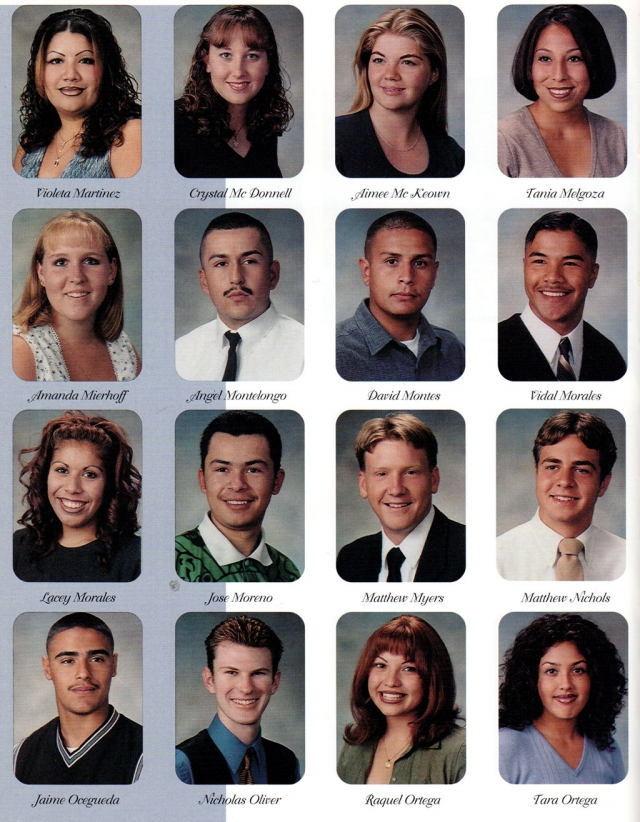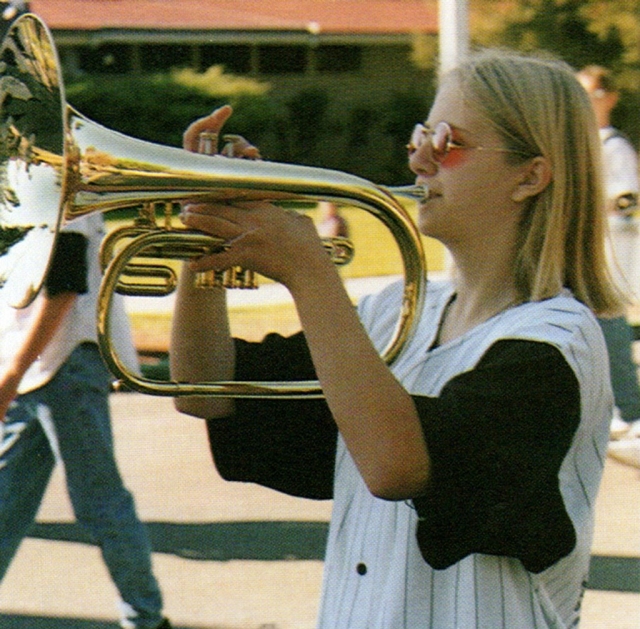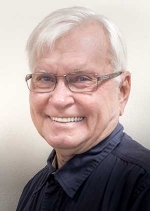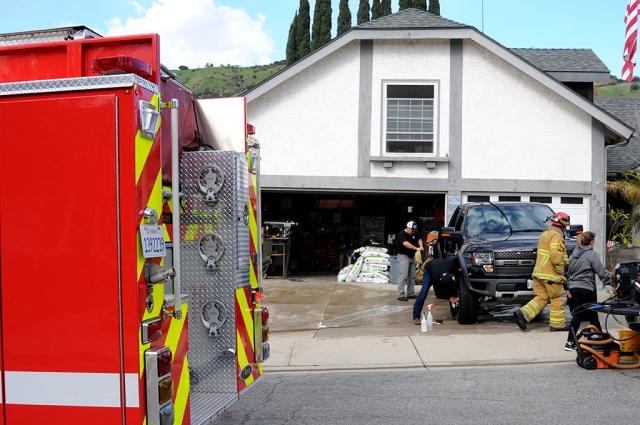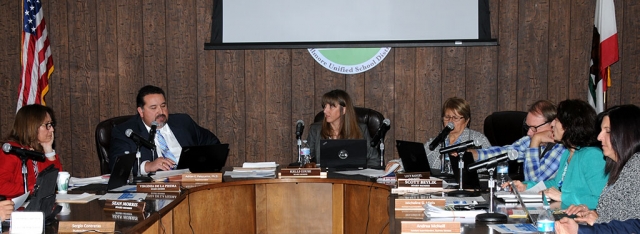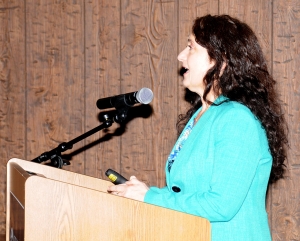|
By Anonymous — Wednesday, February 27th, 2019
At Tuesday's regular City Council meeting the following actions were taken: Staff submitted for review the 1) Mid-Year Financial Report, which is the fiscal year to date through mid-year financial results, and the Financial Forecast through the remainder of the fiscal year for the General, Water, Sewer, Recreation, Community Pool and Street Funds; 2) a summary of the Fund Balance by Fund (Attachment A) starting with FY 2014-15 plus the forecast for the current fiscal year impact on fund balance and the ending fund balance; 3) request to approve a Supplemental Budget Request (Attachment B), and 4) list of the Accomplishments (Attachment C) achieved for each department in Year 2018. For complete details please consult: City of Fillmore Agenda for 2-27-2019 online. The City Council approved the first reading of Ordinance No. 19-900, limiting oversized vehicle parking on River Street between D Street and the treatment plant and on E Street south of State Route 126 to 2 hours or less. A request has been made that Council members serve as official representatives of the City to various intergovernmental agencies. The Southern California Association of Governments (SCAG) allows each member City to appoint a delegate to vote at the General Assembly business meeting. At this meeting, the SCAG membership considers and takes action on resolutions that establish SCAG policy. In order to vote at the General Assembly business meeting the City Council must designate a voting delegate and alternate, who may vote in the event that the designated voting delegate is unable to serve in that capacity. The Regional Conference and General Assembly is scheduled: Date: Thursday and Friday, May 2-3, 2019Time9:00 a.m. Location: JW Marriott Resort & Spa, 74-855 Country Club Drive, Palm Desert, CA 92260 Each Delegate or Alternate will receive a complimentary one-night hotel accommodation at the JW Marriott Resort & Spa for the night of May 2nd; validated overnight parking and meals during the conference. Councilman Tim Holmgren was designated primary voting delegate. A discussion concerning affordable housing, led by City Manager David Rowlands, took place. |
|
By Anonymous — Wednesday, February 27th, 2019
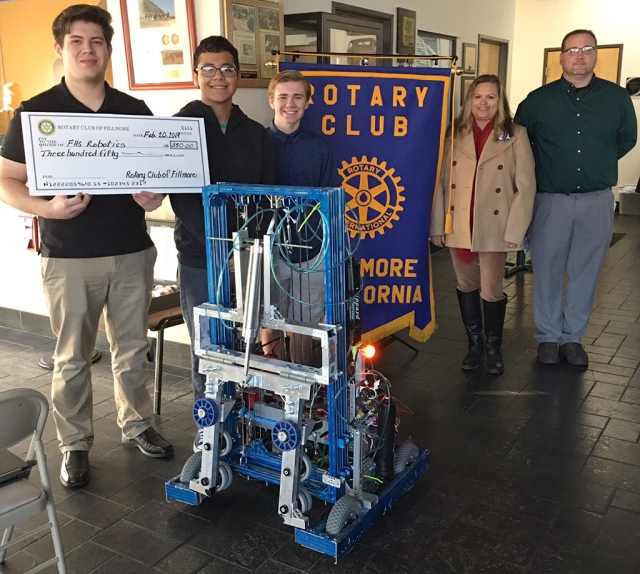 Fillmore Rotary Club presented a check for $350 to the FHS Robotics team. Pictured (l-r) is Damian, Jesus, Matt, Pres.-Elect Ari Larson, Mr. McMahan and some of the students from the FHS Robotics team. The team brought their latest project to share with the club. They also shared that they are preparing to compete at Ventura College with teams from around the world. Photo courtesy Martha Richardson. Enlarge Photo |
Now Hiring: Deputy City Clerk
The City of Fillmore is seeking a detail-oriented and highly organized professional to join our City Clerk’s Office as Deputy City Clerk. This key role supports City Council operations, maintains official records, ensures legal compliance, and helps uphold transparency in local government. If you’re passionate about public service, governance, and supporting elected officials, we encourage you to apply. Learn more and apply at www.fillmoreca.gov.
 Pictured are construction crews preparing for the installation of 120 new storage units and new office at Nova Storage. Photos by Bob Crum. Enlarge Photo By Bob Crum — Wednesday, February 27th, 2019
Why is there fencing protruding into A and 1st streets? It's due to an extensive expansion and improvement project at Nova Storage. Inside, 120 new self-storage units are being built. Also, to improve customer service, a new rental office is being built on the A Street side of the building. Like the existing storage units, the newly built storage units will be individually alarmed. Cameras inside and outside will provide additional security. New interior lighting includes state-of-the-art sensors that regulate the intensity of the new LED lights according to the ambient light in the building. Outside, the new sidewalk and soon to be paved parking lot will complete the building front. At the rear of the property, accessed off Landeros Lane, big earth moving machines are tearing up the lower RV parking lot. With the grading done, the area gets beautifully paved for the first time in its history. New perimeter lighting and security cameras will complete the RV parking lot improvements. If all goes according to plan, Fillmore residents can expect the exciting grand opening of a first-class storage facility sometime in April. |
|
By Mark Ortega — Wednesday, February 27th, 2019
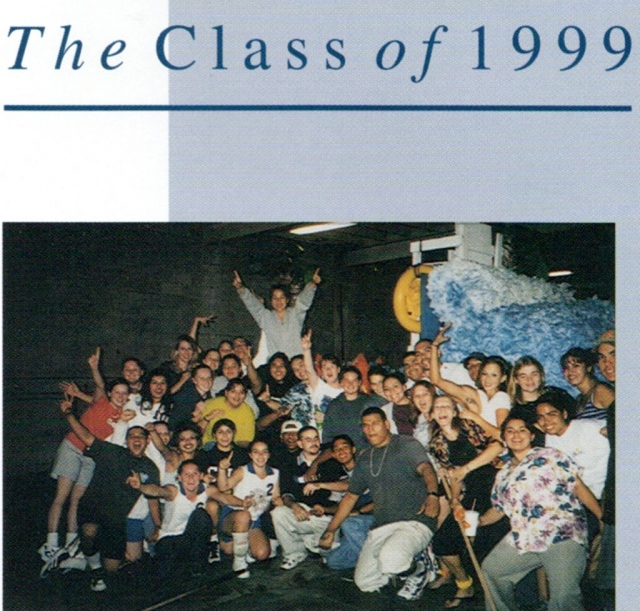 The Fillmore High Class of 1999 will be partying like it’s 1999 on June 8th, 2019 at the 106th Annual Fillmore High Alumni Dinner! They will be seated together in a space reserved for honored classes. This year’s honored classes are class years that end in 4 and 9. In the class of 1999’s reserved section, they will be seated at round tables of 10 and they will be able to decorate their own section the way they wish. All Alumni are welcomed to attend. To confirm your reservation for the 106th Annual Alumni Dinner, please go to www.fillmorehighalumni.com and click on “Events”. The past two years this event has been sold out, so get your reservations in early! Enlarge Photo |
 Photo of the Week "Hawk flies off taking mouse to the dining table" by Bob Crum. Photo data: Canon 7DMKII camera, manual mode. Tamron 16-300mm lens @300mm. Exposure: ISO 500, aperture f/11, 1/800th second shutter speed. Enlarge Photo By Bob Crum — Wednesday, February 27th, 2019
Phonetography, again!
I didn't foresee last weeks mild-mannered column disturbing so many readers. Mention of recently announced cameras seemed innocuous. HA! I was besieged with a barrage of emails haranguing me on the folly of my topics. Some writers were obstinately defiant. Given forethought, I would have discussed how to boost your euphoric level of dopamine by re-reading a camera's operating manual while snacking on baked brussels sprouts. But I digress. A typical email came from reader Jon (not his real name) who wrote: “I had a peaceful life until I read your column discussing the new Canon RP camera. “Excitedly, I told my wife that I'm going to buy one. A skirmish ensued. The doctor said I could remove the head bandage next week and I'm still sleeping in the garage, with the cat.” Men: Never talk about buying a new camera without renewing your lady's spa membership - for a year! Ladies: the quickest way to delight your significant other is to buy him a spanking new camera - and two lenses. Oh, and don't forget a camera bag that matches your purse. Just a thought. And there's this admonishment from Larry K. (again not his real name): “Why do you continue promoting a dead methodology? I take great photos with my (brand name deleted to protect the manufacturer) smartphone. You need to get up to date, sir!” The 'sir' part endeared me to Larry K. Sir, I replied, thanks for writing. However, have you ever photographed the Blue Angels with your cellphone? How'd that work out? How about a rodeo? Given that selfie-afflicted phonetographers seem to outnumber photographers 7,392,802 to 1, I receive a continuous stream of emails touting phenomenal cellphone photos. I don't suggest that everyone tote a camera along with their cellphone. Phonetography has merit! I shoot cellphone snapshots when circumstances allow, and I need to email or text a snapshot quickly. But in many situations, a dedicated camera undeniably smokes a cellphone! Before emailing me objecting vehemently, let's briefly explore a few cellphone limitations. The cellphone's thin form factor prohibits an optical zoom lens. Digital zoom (cropping) degrades photo quality. Has anyone seen a 'professional phonetographer' at a pro sports event? How about photographing a fast-flying osprey skimming a lake on a bright sunny day with a cellphone? Or grandson Lenny kicking a soccer goal! Good luck! Also, while cameras in current top-end cellphones are continually improving, they still struggle in low-light situations because of their ultra-small sensors. The larger sensors of dedicated camera's increase light gathering abilities. Another cellphone disadvantage is the fixed aperture that prevents controlling depth-of-field (DOF) when desired. Some cellphones are trying to emulate DOF with firmware, but it's still woefully deficient. Essentially, shutter speed, aperture and ISO control exposure. A dedicated camera offers extensive exposure control, and creative DOF options, whereas cellphones have minimal options. Last, there's therapeutic value in 'creating' a photo with a dedicated camera. Tapping an icon on a cellphone to take a snapshot is hardly creative. Just a thought. Bottom line: The best camera is the one you have with you, as the cliché goes, even if it's a cellphone. Peace! The photo of the week is the last of the hawk series. Anticipating a fast flight, I quickly increased the shutter speed to 1/800th of a second for stability during panning and still illustrate some wingtip blur to indicate motion. Creativity in action. Send comments, suggestions and/or questions to: focusonphotography@earthlink.net |
|
By Anonymous — Monday, February 25th, 2019
Semi-Finals and Finals Open to Public and Media
More than two dozen local high schools will field 30 teams in the Ventura County Mock Trial competition, which begins Monday in Ventura. Courtroom drama comes to life as students take on the major roles of a criminal case, including attorneys, witnesses and even bailiffs. The students will present their cases before actual local judges who volunteer for the competition. Local attorneys serve as coaches. WHAT: 2019 Ventura County Mock Trial WHEN: The competition runs Monday, February 25 to Thursday, February 28. The Wednesday semi-finals and Thursday finals are open to the public and the media. Competition begins each evening at 5:00 pm and is expected to conclude by 11:00 pm. • Monday, February 25 – Rounds 1 and 2 WHERE: Ventura County Superior Court - 800 South Victoria Avenue, Ventura, California 93009 CHECK IN: Members of the media are asked to check in at the registration desk upon arrival Awards Ceremony About the 2019 Ventura County Mock Trial High schools participating this year are: Adolfo Camarillo High School, Agoura High School, Buena High School, Calabasas High School, Channel Islands High School, Fillmore High School, Grace Brethren Jr/Sr High School, La Reina High School, Newbury Park High School, Nordhoff High School, Oak Park High School, Oaks Christian School, Oxnard High School, Rio Mesa, Royal High School, Saint Bonaventure High School, Santa Paula High School, Santa Susana High School, Simi Valley High School, St. Augustine Academy, Thousand Oaks High School, Trinity Pacific Christian School, Ventura High School, Villanova Preparatory School and Westlake High School. The winner of the county competition will go on to the state mock trial contest March 22-24 in Sacramento. Ventura County has taken first place at the state level in 2008, 2011, 2012 and 2013. This year’s Ventura County Mock Trial logo artwork was created by Alexandra Clark from La Reina High School in Thousand Oaks. Additional information about the 2019 Ventura County Mock Trial is available at vcoe.org/mocktrial. |
|
By Anonymous — Monday, February 25th, 2019
|
 Fillmore High School Wrestler Adrian Bonilla placed 8th in the CIF Masters Wrestling Tournament this past weekend at Cerritos Community College. Adrian finished the tournament going 3-3. He is the first male wrestler in the program’s 30+ years history to qualify to go to state. Photo courtesy Coach Jorge Bonilla. Enlarge Photo By John Wilber — Wednesday, February 20th, 2019
By John Wilber, Fillmore High School Principal. A historic first, Fillmore High School wrestler Adrian Bonilla, has advanced to the State Wrestling Tournament in Bakersfield this Thursday. Adrian is a Fillmore High School senior, 195 pound wrestler, who was also the Citrus Coastal League Champion in his weight class. He placed 5th in the Southern Section California Interscholastic Federation (CIF) Finals two weeks ago which earned him a trip to the CIF Masters Wrestling Tournament last weekend. At the Masters Tournament Adrian was 3-2 after two days of wrestling which was good for an 8th place, qualifying him for the State Tournament. Adrian is the first Fillmore High wrestler to advance to the State Tournament since the wrestling program started at Fillmore High School in 1987. Fillmore High School Coach, Manual Ponce shared that Adrian exemplifies the ideal wrestler because he is very coachable, a very smart wrestler and he is all about work ethic. Adrian has had to overcome a knee injury his junior year on his path to success this year. Adrian is the third wrestling son of Jorge and Lurdes Bonilla. Mr. Bonilla mentioned that Adrian has been around wrestling since he was seven years old, when he would hang around the wrestling practices of his older brothers Robert and Andres. His years of hard work and commitment have definitely paid off. Adrian is very excited about his opportunity to wrestle at the State level and to represent Fillmore High School and the Fillmore Community. He stated, “I have been motivated to do well since I last went to Masters my sophomore year.” “I am in great shape and I have the desire to compete.” We wish Adrian the best of luck in Bakersfield. |
|
By Anonymous — Wednesday, February 20th, 2019
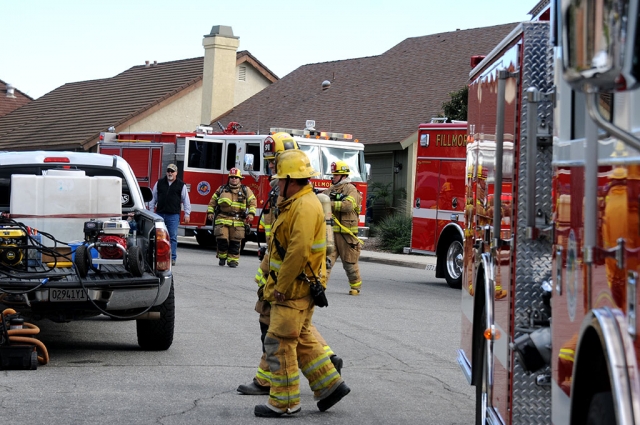 On Monday, February 18th Fillmore Fire Department responded to a stove fire call on Stonehedge Drive. Crews arrived quickly to put out the flames. No injuries were reported at the scene; damage was unreported. Enlarge Photo |

